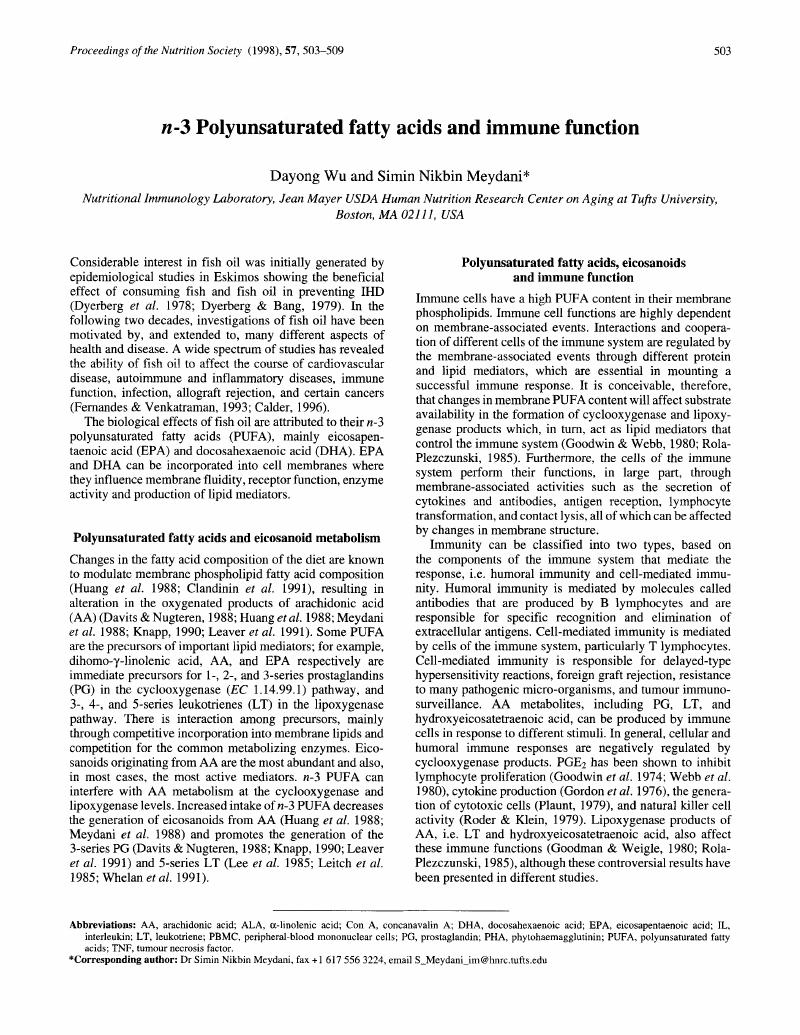Crossref Citations
This article has been cited by the following publications. This list is generated based on data provided by Crossref.
Pablo, Manuel A
Ãngeles Puertollano, Ma
and
Ãlvarez de Cienfuegos, Gerardo
2000.
Immune cell functions, lipids and host natural resistance.
FEMS Immunology & Medical Microbiology,
Vol. 29,
Issue. 4,
p.
323.
Suchner, U.
Kuhn, K. S.
and
Fürst, P.
2000.
The scientific basis of immunonutrition.
Proceedings of the Nutrition Society,
Vol. 59,
Issue. 4,
p.
553.
Fürst, P.
and
Kuhn, K.S.
2000.
Fish oil emulsions: what benefits can they bring?.
Clinical Nutrition,
Vol. 19,
Issue. 1,
p.
7.
Calder, Philip C.
2001.
The ratio of n-6 to n-3 fatty acids in the diet: Impact on T lymphocyte function.
European Journal of Lipid Science and Technology,
Vol. 103,
Issue. 6,
p.
390.
Arita, Kayo
Kobuchi, Hirotsugu
Utsumi, Toshihiko
Takehara, Yoshiki
Akiyama, Jitsuo
Horton, Alan A
and
Utsumi, Kozo
2001.
Mechanism of apoptosis in HL-60 cells induced by n-3 and n-6 polyunsaturated fatty acids 1 1Abbreviations: AA, arachidonic acid; CsA, cyclosporin A; Cyt.c, cytochrome c; DCFH-DA, 2′,7′-dichlorofluorescein diacetate; DPA, docosapentaenoic acid; EPA, eicosapentaenoic acid; HE, hydroethidine; JC-1, 5,5′,6,6′-tetrachloro-1,1′,3,3′-tetraethylbenzimidazol carbocyanine iodide; MPT, membrane permeability transition; PUFA, polyunsaturated fatty acid; ROS, reactive oxygen species; and z-VAD-fmk, z-Val-Ala-Asp(OMe)-fluoromethylketone..
Biochemical Pharmacology,
Vol. 62,
Issue. 7,
p.
821.
Anderson, Michele
and
Fritsche, Kevin L.
2002.
(n-3) Fatty Acids and Infectious Disease Resistance.
The Journal of Nutrition,
Vol. 132,
Issue. 12,
p.
3566.
Levy, Joseph
and
Turkish, Aaron
2002.
Protective nutrients.
Current Opinion in Gastroenterology,
Vol. 18,
Issue. 6,
p.
717.
Calder, P. C.
Yaqoob, P.
Thies, F.
Wallace, F. A.
and
Miles, E. A.
2002.
Fatty acids and lymphocyte functions.
British Journal of Nutrition,
Vol. 87,
Issue. S1,
p.
S31.
Pestka, James J.
Zhou, Hui-Ren
Jia, Qunshan
and
Timmer, Ann M.
2002.
Dietary Fish Oil Suppresses Experimental Immunoglobulin A Nephropathy in Mice.
The Journal of Nutrition,
Vol. 132,
Issue. 2,
p.
261.
Bisgaard, Thue
and
Kehlet, Henrik
2002.
Early oral feeding after elective abdominal surgery—what are the issues?.
Nutrition,
Vol. 18,
Issue. 11-12,
p.
944.
Irons, Robert
Anderson, Michele J.
Zhang, Meijuan
and
Fritsche, Kevin L.
2003.
Dietary Fish Oil Impairs Primary Host Resistance Against Listeria monocytogenes More than the Immunological Memory Response.
The Journal of Nutrition,
Vol. 133,
Issue. 4,
p.
1163.
Moon, Yuseok
and
Pestka, James J.
2003.
Deoxynivalenol-induced mitogen-activated protein kinase phosphorylation and IL-6 expression in mice suppressed by fish oil.
The Journal of Nutritional Biochemistry,
Vol. 14,
Issue. 12,
p.
717.
Horrocks, Lloyd A
and
Farooqui, Akhlaq A
2004.
Docosahexaenoic acid in the diet: its importance in maintenance and restoration of neural membrane function.
Prostaglandins, Leukotrienes and Essential Fatty Acids,
Vol. 70,
Issue. 4,
p.
361.
Nguyen, L. Q.
Everts, H.
and
Beynen, A. C.
2004.
Influence of dietary linseed, fish and coconut oil on growth performance of growing pigs kept on small holdings in central Vietnam.
Journal of Animal Physiology and Animal Nutrition,
Vol. 88,
Issue. 5-6,
p.
204.
DIXIT, MEHUL P
DIXIT, NAZNIN M
and
SCOTT, KATHERINE
2004.
Managing Henoch–Schonlein purpura in children with fish oil and ACE inhibitor therapy.
Nephrology,
Vol. 9,
Issue. 6,
p.
381.
Thanasak, J.
Rutten, V. P. M. G.
Schonewille, J. Th.
Hoek, A.
Beynen, A. C.
Noordhuizen, J. P. T. M.
and
Müller, K. E.
2004.
Effect of a Dietary n‐6 Polyunsaturated Fatty Acid Supplement on Distinct Immune Functions of Goats.
Journal of Veterinary Medicine Series A,
Vol. 51,
Issue. 1,
p.
1.
Zhang, Meijuan
and
Fritsche, Kevin L.
2004.
Fatty acid-mediated inhibition of IL-12 production by murine macrophages is independent of PPARγ.
British Journal of Nutrition,
Vol. 91,
Issue. 5,
p.
733.
van Meeteren, M E
Teunissen, C E
Dijkstra, C D
and
van Tol, E A F
2005.
Antioxidants and polyunsaturated fatty acids in multiple sclerosis.
European Journal of Clinical Nutrition,
Vol. 59,
Issue. 12,
p.
1347.
Thanasak, J.
Müller, K.E.
Dieleman, S.J.
Hoek, A.
Noordhuizen, J.P.T.M.
and
Rutten, V.P.M.G.
2005.
Effects of polyunsaturated fatty acids on the proliferation of mitogen stimulated bovine peripheral blood mononuclear cells.
Veterinary Immunology and Immunopathology,
Vol. 104,
Issue. 3-4,
p.
289.
Shirota, Tetsuya
Haji, Seiji
Yamasaki, Mitsuo
Iwasaki, Takuya
Hidaka, Toshiharu
Takeyama, Yoshifumi
Shiozaki, Hitoshi
and
Ohyanagi, Harumasa
2005.
Apoptosis in human pancreatic cancer cells induced by eicosapentaenoic acid.
Nutrition,
Vol. 21,
Issue. 10,
p.
1010.





